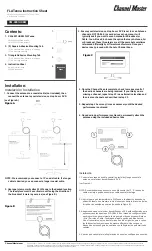
Setup – Satellite Configuration
6012-12W Installation Manual
10.
Setup – Satellite Configuration
If you are using a remotely controlled ABS network control configuration (ie OpenAMIP, ROAM or legacy ABS
direct connection to the MXP disregard this chapter as the network will make all changes in the MXP for the new
beam or satellite to be used.
The values that these parameters are set to depends on the hardware configuration required for each satellite.
Configure each of the satellites that airtime services will be provided on so that any one of them can be selected,
remotely or by the user onboard. The satellite selection will in turn control the hardware on the antenna pedestal to
select the correct TX & RX hardware and the correct tracking settings.
Sea Tel provides quad-band LNBs as standard on the Ku-Band feed assemblies.
10.1.
Searching Patterns
The MXP will initiate an automated search pattern after AGC falls below the current Threshold setting
(indicates that satellite signal has been lost). The SEARCH DELAY parameter sets the amount of delay, in
seconds that the MXP will wait after AGC has fallen below the threshold value before it starts a search. Below
are the choices of patterns that each satellite can be set to.
10.1.1.
Default “Spiral” (Box) Search Pattern
The factory default search pattern in the MXP is a “Spiral” pattern.
When a search begins;
The antenna will then search up in azimuth one Search Increment,
search up one Search Increment in elevation, search down two
Search Increments in azimuth, search down two Search
Increments in elevation, etc until Search Limit is reached. When
the end of the search pattern is reached, the MXP will retarget the
antenna to the calculated Azimuth and Elevation position of the
desired satellite (start point).
If the desired signal is found (AND network lock is achieved in the satellite modem) at this position,
or anywhere within the search pattern, the MXP will terminate search and go into Tracking mode. If
the desired signal is not found the MXP will wait SEARCH DELAY seconds and then begin the
search pattern again. This cycle will repeat until the desired satellite signal is found or the operator
intervenes.
10.1.2.
Inclined Orbit Search Pattern
Some older satellites, in order to save fuel to keep them exactly positioned over the Equator, are
in an inclined geosynchronous orbit. The satellite remains
geosynchronous but is no longer geostationary. From a fixed
observation point on Earth, it would appear to trace out a figure-
eight with lobes oriented north-southward once every twenty-
four hours. The north-south excursions of the satellite may be too
far off the center point for a default box search pattern to find that
satellite at all times during the 24 hour period.
When a search begins;
Initially the antenna will go to a calculated position that is half of
SWEEP INCR degrees above, and perpendicular to, the satellite arc (along the same angle as
polarization for the desired satellite). This position is the “Start” of the search pattern in the graphic
above. Then the antenna will drive down along the polarization angle SWEEP INCR degrees, step
one Search Increment to the right (parallel to the satellite arc), search up along the polarization
angle SWEEP INCR degrees, step two Search Increments to the left, search down, etc expanding out
in the search pattern until Search Limit is reached. When the end of the search pattern is reached,
the MXP will retarget the antenna to the calculated Azimuth and Elevation point.
10-1
EAR Controlled - ECCN EAR99
Summary of Contents for 6012-12w
Page 101: ......
Page 102: ......
Page 103: ......
Page 106: ...8 7 6 5 4 D 5 C B A 8 7 6 5 4 ...
Page 116: ...8 7 6 5 4 3 50 58 58 59 2X 1 52 58 58 59 2X ...
Page 120: ......
Page 128: ......
Page 129: ......
Page 130: ......
















































